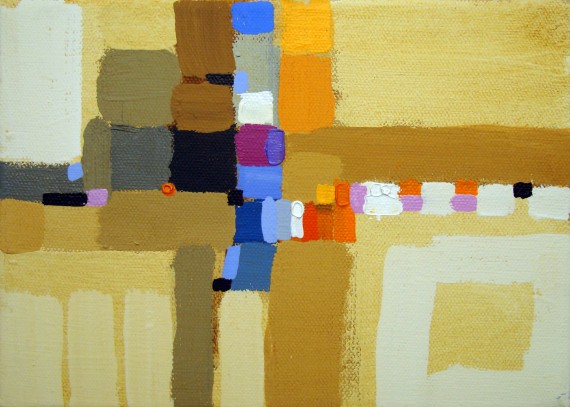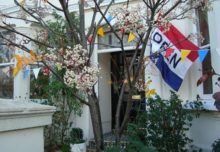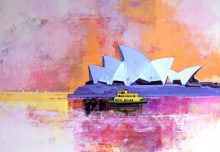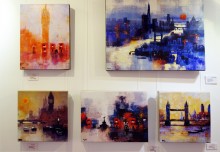ABSTRACT ART IS LIKE FROZEN MUSIC
The idea of claiming that abstract art is like frozen music came about because some otherwise very worthy people just don’t get the idea of abstraction in art at all. My mum didn’t. I will admit that I didn’t when I was a youth. Personally I had one of those epiphany moments in my teens when the scales fell off my eyes and it all began to make sense.
The frozen music explanation evolved after years trying to justify why abstract art is valid, worthy, and good, as opposed to being a delusion or confidence trick. I am afraid that my own mother was one of the sceptics. This is how I tried to share the wonder of abstract art with her. I told her it was like music.

190109 ABSTRACT by Colin Ruffell
But music and painting are such different things!
The similarity between visual art such as paintings, and creative sound like music, is not obvious.
A painting is a flat surface covered in paint and experienced with your eyes. The picture is usually about something, it is either a view, a person, or a happening. A painter captures what he or she sees, or recreates the happening by visualising what it looks like, and making paint look the same. It is two [or sometimes three] dimensional. The viewer experiences the effect as long as they like. It is stable.
Whereas music is deliberate, pleasant, passing sound. It uses a different dimension entirely. It has rhythm and range for sure but it has no stable physical substance, it exists in a moving time frame. Often it is used as an attractive way to get a message across. A poem with nice sounds, or an emotional experience created or recreated in the mind using memory and association.
But luckily music has a quality that is totally understood and accepted by everyone. It can be equally valid with or without words. And luckily most people have an understanding of the difference between music with words and music without words. Songs, hymns, and opera are examples of music with words. Whereas music such as most orchestral symphonies, instrumentals, guitar solos, and such, are common examples of music that is just music. Without words it is all about itself and whether it sounds good.
Art with a subject is like music that has words.
Music with words is like a painting with a subject.
Music without words, is like abstract or ‘non-subjective’ art.
Abstract art is like instrumental music. It isn’t about anything. It just is.
Simple. My Mum understood the idea.
The next question.
Instrumental music has been around for a very long time.
So why did abstract painting take so long to arrive?
For hundreds, no thousands, of years painting and sculpture has depicted something or the other. It was only at the start of the last century that artists had the idea that they could make art that wasn’t about a subject.
Of course there had always been some abstract visual art in the form of patterns, but it was seen as trivial compared to subjective fine-art.
Artists had been happily developing Impressionism showing landscapes, flowers, and dancers in lovely colours. Then something happened and my mother was appalled!
Firstly cubists started to make art that was still about something but it was all broken up. Then about a hundred years ago in 1913 the Russian artist Malevitch produced a simple black square that blew people’s minds. It was so easy to make and so difficult to understand why and what it was all about.
The black square is very simple.
If you could just stop music running on and on, maybe you could just hear one single piece before it changed. Maybe you could freeze a single moment of the music without words and stop it changing. Suppose that the moment that you froze the sound it was like a black square. So far so good.
What kind of music is the same as the black square? I couldn’t hope to explain that to my mum. But at the time that I was making the attempt the American artist Jackson Pollock was dripping paint all over canvases in an emotional seemingly random way. She agreed that was something like jazz.
A bit later Mark Rothko made big humming buzzing blocks of fuzzy colour that had a sort of deep sound like a bit of Elgar cello.
And Bridget Riley made eye catching sharp edged stuff that felt tidy and sharp edged like a classical string quartet, and so on.
An abstract painting is like a frozen moment of time with the musical sound of that moment turned into colour, shape, scale and texture.
Get the idea?
In my next blog post I hope to explore Rothko and Pollock a bit more.




